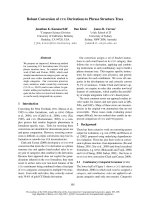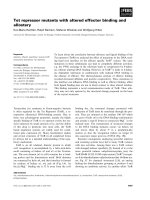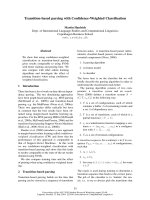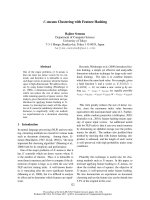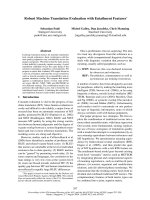Báo cáo khoa học: "Robust pronoun resolution with limited knowledge" pot
Bạn đang xem bản rút gọn của tài liệu. Xem và tải ngay bản đầy đủ của tài liệu tại đây (620.91 KB, 7 trang )
Robust pronoun resolution with limited knowledge
Ruslan Mitkov
School of Languages and European Studies
University of Wolverhampton
Stafford Street
Wolverhampton WV 1 1SB
United Kingdom
R. Mitkov@wlv. ac. uk
Abstract
Most traditional approaches to anaphora resolution
rely heavily on linguistic and domain knowledge.
One of the disadvantages of developing a knowledge-
based system, however, is that it is a very labour-
intensive and time-consuming task. This paper pres-
ents a robust, knowledge-poor approach to resolving
pronouns in technical manuals, which operates on
texts pre-processed by a part-of-speech tagger. Input
is checked against agreement and for a number of
antecedent indicators. Candidates are assigned scores
by each indicator and the candidate with the highest
score is returned as the antecedent. Evaluation reports
a success rate of 89.7% which is better than the suc-
cess rates of the approaches selected for comparison
and tested on the same data. In addition, preliminary
experiments show that the approach can be success-
fully adapted for other languages with minimum
modifications.
1. Introduction
For the most part, anaphora resolution has focused
on traditional linguistic methods (Carbonell &
Brown 1988; Carter 1987; Hobbs 1978; Ingria &
Stallard 1989; Lappin & McCord 1990; Lappin &
Leass 1994; Mitkov 1994; Rich & LuperFoy 1988;
Sidner 1979; Webber 1979). However, to represent
and manipulate the various types of linguistic and
domain knowledge involved requires considerable
human input and computational expense.
While various alternatives have been proposed,
making use of e.g. neural networks, a situation se-
mantics framework, or the principles of reasoning
with uncertainty (e.g. Connoly et al. 1994; Mitkov
1995; Tin & Akman 1995), there is still a strong
need for the development of robust and effective
strategies to meet the demands of practical NLP
systems, and to enhance further the automatic pro-
cessing of growing language resources.
Several proposals have already addressed the
anaphora resolution problem by deliberately limiting
the extent to which they rely on domain and/or lin-
guistic knowledge (Baldwin 1997; Dagan & Itai
1990; Kennedy & Boguraev 1996; Mitkov 1998;
Nasukawa 1994; Williams et al. 1996). Our work is
a continuation of these latest trends in the search for
inexpensive, fast and reliable procedures for anaph-
ora resolution. It is also an example of how anaphors
in a specific genre can be resolved quite successfully
without any sophisticated linguistic knowledge or
even without parsing. Finally, our evaluation shows
that the basic set of antecedent tracking indicators
can work well not only for English, but also for
other languages (in our case Polish and Arabic).
2. The approach
With a view to avoiding complex syntactic, seman-
tic and discourse analysis (which is vital for real-
world applications), we developed a robust, knowl-
edge-poor approach to pronoun resolution which
does not parse and analyse the input in order to
identify antecedents of anaphors. It makes use of
only a part-of-speech tagger, plus simple noun
phrase rules (sentence constituents are identified at
the level of noun phrase at most) and operates on the
basis of antecedent-tracking preferences (referred to
hereafter as "antecedent indicators"). The approach
works as follows: it takes as an input the output of a
text processed by a part-of-speech tagger, identifies
the noun phrases which precede the anaphor within a
distance of 2 sentences, checks them for gender and
number agreement with the anaphor and then applies
the genre-specific antecedent indicators to the re-
maining candidates (see next section). The noun
phrase with the highest aggregate score is proposed
as antecedent; in the rare event of a tie, priority is
given to the candidate with the higher score for im-
mediate reference. If immediate reference has not
been identified, then priority is given to the candi-
869
date with the best collocation pattern score. If this
does not help, the candidate with the higher score
for indicating verbs is preferred. If still no choice is
possible, the most recent from the remaining candi-
dates is selected as the antecedent.
2.1 Antecedent indicators
Antecedent indicators (preferences) play a decisive
role in tracking down the antecedent from a set of
possible candidates. Candidates are assigned a score
(-1, 0, 1 or 2) for each indicator; the candidate with
the highest aggregate score is proposed as the ante-
cedent. The antecedent indicators have been identi-
fied empirically and are related to salience
(definiteness, givenness, indicating verbs, lexical
reiteration, section heading preference, "non-
prepositional" noun phrases), to structural matches
(collocation, immediate reference), to referential
distance or to preference of terms. Whilst some of
the indicators are more genre-specific (term prefer-
ence) and others are less genre-specific ("immediate
reference"), the majority appear to be genre-
independent. In the following we shall outline some
the indicators used and shall illustrate them by ex-
amples.
Indicating verbs
If a verb is a member of the Verb_set = {discuss,
present, illustrate, identify, summarise, examine,
describe, define, show, check, develop, review, re-
port, outline, consider, investigate, explore, assess,
analyse, synthesise, study, survey, deal, cover}, we
consider the first NP following it as the preferred an-
tecedent (scores 1 and 0). Empirical evidence sug-
gests that because of the salience of the noun
phrases which follow them, the verbs listed above
are particularly good indicators.
Lexical reiteration
Lexically reiterated items are likely candidates for
antecedent (a NP scores 2 if is repeated within the
same paragraph twice or more, 1 if repeated once
and 0 if not). Lexically reiterated items include re-
peated synonymous noun phrases which may often
be preceded by definite articles or demonstratives.
Also, a sequence of noun phrases with the same
head counts as lexical reiteration (e.g. "toner bottle",
"bottle of toner", "the bottle").
Section heading preference
Definiteness
Definite noun phrases in previous sentences are
more likely antecedents of pronominal anaphors
than indefinite ones (definite noun phrases score 0
and indefinite ones are penalised by -1). We regard a
noun phrase as definite if the head noun is modified
by a definite article, or by demonstrative or posses-
sive pronouns. This rule is ignored if there are no
definite articles, possessive or demonstrative pro-
nouns in the paragraph (this exception is taken into
account because some English user's guides tend to
omit articles).
Givenness
Noun phrases in previous sentences representing the
"given information" (theme) 1 are deemed good
candidates for antecedents and score 1 (candidates
not representing the theme score 0). In a coherent
text (Firbas 1992), the given or known information,
or theme, usually appears first, and thus forms a co-
referential link with the preceding text. The new
information, or rheme, provides some information
about the theme.
lWe use the simple heuristics that the given information
is the first noun phrase in a non-imperative sentence.
870
If a noun phrase occurs in the heading of the section,
part of which is the current sentence, then we con-
sider it as the preferred candidate (1, 0).
"Non-prepositional" noun phrases
A "pure", "non-prepositional" noun phrase is given a
higher preference than a noun phrase which is part
of a prepositional phrase (0, -1). Example:
Insert the cassette i into the VCR making sure it i is
suitable for the length of recording.
Here "the VCR" is penalised (-1) for being part of
the prepositional phrase "into the VCR".
This preference can be explained in terms of sali-
ence from the point of view of the centering theory.
The latter proposes the ranking "subject, direct ob-
ject, indirect object" (Brennan et al. 1987) and noun
phrases which are parts of prepositional phrases are
usually indirect objects.
Collocation pattern preference
This preference is given to candidates which have an
identical collocation pattern with a pronoun (2,0).
The collocation preference here is restricted to the
patterns "noun phrase (pronoun), verb" and "verb,
noun phrase (pronoun)". Owing to lack of syntactic
information, this preference is somewhat weaker
than the collocation preference described in (Dagan
& Itai 1990). Example:
Press the key i down and turn the volume up Press
it i again.
Immediate reference
In technical manuals the "immediate reference" clue
can often be useful in identifying the antecedent.
The heuristics used is that in constructions of the
form " (You) V l NP con (you) V 2 it (con (you)
V 3 it)", where con ~ {and/or/before/after }, the
noun phrase immediately after V l is a very likely
candidate for antecedent of the pronoun "it" imme-
diately following V 2 and is therefore given prefer-
ence (scores 2 and 0).
This preference can be viewed as a modification
of the collocation preference. It is also quite fre-
quent with imperative constructions. Example:
To print the paper, you can stand the printer i up or
lay it i flat.
To turn on the printer, press the Power button i and
hold it i down for a moment.
Unwrap the paper i, form it i and align it i, then load it i
into the drawer.
Referential distance
In complex sentences, noun phrases in the previous
clause 2 are the best candidate for the antecedent of
an anaphor in the subsequent clause, followed by
noun phrases in the previous sentence, then by nouns
situated 2 sentences further back and finally nouns 3
sentences further back (2, 1, 0, -1). For anaphors in
simple sentences, noun phrases in the previous sen-
tence are the best candidate for antecedent, followed
by noun phrases situated 2 sentences further back
and finally nouns 3 sentences further back (1, 0, -1).
Term preference
NPs representing terms in the field are more likely
to be the antecedent than NPs which are not terms
(score 1 if the NP is a term and 0 if not).
2Identification of clauses in complex sentences is done
heuristically.
871
As already mentioned, each of the antecedent in-
dicators assigns a score with a value {-1, 0, 1, 2}.
These scores have been determined experimentally
on an empirical basis and are constantly being up-
dated. Top symptoms like "lexical reiteration" as-
sign score "2" whereas "non-prepositional" noun
phrases are given a negative score of "-1". We
should point out that the antecedent indicators are
preferences and not absolute factors. There might be
cases where one or more of the antecedent indicators
do not "point" to the correct antecedent. For in-
stance, in the sentence "Insert the cassette into the
VCR i making sure it i is turned on", the indicator
"non-prepositional noun phrases" would penalise the
correct antecedent. When all preferences (antecedent
indicators) are taken into account, however, the right
antecedent is still very likely to be tracked down - in
the above example, the "non-prepositional noun
phrases" heuristics (penalty) would be overturned by
the "collocational preference" heuristics.
2.2 Informal description of the algorithm
The algorithm for pronoun resolution can be de-
scribed informally as follows:
1. Examine the current sentence and the two pre-
ceding sentences (if available). Look for noun
phrases 3 only to the left of the anaphor 4
2. Select from the noun phrases identified only
those which agree in gender and number 5 with
the pronominal anaphor and group them as a set
of potential candidates
3. Apply the antecedent indicators to each poten-
tial candidate and assign scores; the candidate
with the highest aggregate score is proposed as
3A sentence splitter would already have segmented the
text into sentences, a POS tagger would already have
determined the parts of speech and a simple phrasal
grammar would already have detected the noun phrases
4In this project we do not treat cataphora; non-anaphoric
"it" occurring in constructions such as "It is important",
"It is necessary" is eliminated by a "referential filter"
5Note that this restriction may not always apply in lan-
guages other than English (e.g. German); on the other
hand, there are certain collective nouns in English which
do not agree in number with their antecedents (e.g.
"government", "team", "parliament" etc. can be referred
to by "they"; equally some plural nouns (e.g. "data") can
be referred to by "it") and are exempted from the agree-
ment test. For this purpose we have drawn up a compre-
hensive list of all such cases; to our knowledge, no other
computational treatment of pronominal anaphora resolu-
tion has addressed the problem of "agreement excep-
tions".
antecedent. If two candidates have an equal
score, the candidate with the higher score for
immediate reference is proposed as antecedent.
If immediate reference does not hold, propose
the candidate with higher score for collocational
pattern. If collocational pattern suggests a tie or
does not hold, select the candidate with higher
score for indicating verbs. If this indicator does
not hold again, go for the most recent candidate.
3. Evaluation
For practical reasons, the approach presented does
not incorporate syntactic and semantic information
(other than a list of domain terms) and it is not real-
istic to expect its performance to be as good as an
approach which makes use of syntactic and semantic
knowledge in terms of constraints and preferences.
The lack of syntactic information, for instance,
means giving up c-command constraints and subject
preference (or on other occasions object preference,
see Mitkov 1995) which could be used in center
tracking. Syntactic parallelism, useful in discrimi-
nating between identical pronouns on the basis of
their syntactic function, also has to be forgone. Lack
of semantic knowledge rules out the use of verb se-
mantics and semantic parallelism. Our evaluation,
however, suggests that much less is lost than might
be feared. In fact, our evaluation shows that the re-
sults are comparable to syntax-based methods
(Lappin & Leass 1994). We believe that the good
success rate is due to the fact that a number of ante-
cedent indicators are taken into account and no fac-
tor is given absolute preference. In particular, this
strategy can often override incorrect decisions linked
with strong centering preference (Mitkov & Belguith
1998) or syntactic and semantic parallelism prefer-
ences (see below).
3.1 Evaluation A
Our first evaluation exercise (Mitkov & Stys 1997)
was based on a random sample text from a technical
manual in English (Minolta 1994). There were 71
pronouns in the 140 page technical manual; 7 of the
pronouns were non-anaphoric and 16 exophoric. The
resolution of anaphors was carried out with a suc-
cess rate of 95.8%. The approach being robust (an
attempt is made to resolve each anaphor and a pro-
posed antecedent is returned), this figure represents
both "precision" and "recall" if we use the MUC
terminology. To avoid any terminological confusion,
we shall therefore use the more neutral term
"success rate" while discussing the evaluation.
872
In order to evaluate the effectiveness of the ap-
proach and to explore if/how far it is superior over
the baseline models for anaphora resolution, we also
tested the sample text on (i) a Baseline Model which
checks agreement in number and gender and, where
more than one candidate remains, picks as antece-
dent the most recent subject matching the gender
and number of the anaphor (ii) a Baseline Model
which picks as antecedent the most recent noun
phrase that matches the gender and number of the
anaphor.
The success rate of the "Baseline Subject" was
29.2%, whereas the success rate of "Baseline Most
Recent NP" was 62.5%. Given that our knowledge-
poor approach is basically an enhancement of a
baseline model through a set of antecedent indica-
tors, we see a dramatic improvement in performance
(95.8%) when these preferences are called upon.
Typically, our preference-based model proved
superior to both baseline models when the antece-
dent was neither the most recent subject nor the
most recent noun phrase matching the anaphor in
gender and number. Example:
Identify the drawer i by the lit paper port LED and
add paper to it i.
The aggregate score for "the drawer" is 7
(definiteness 1 + givenness 0 + term preference 1 +
indicating verbs l + lexical reiteration 0 + section
heading 0 + collocation 0 + referential distance 2 +
non-prepositional noun phrase 0 + immediate refer-
ence 2 = 7), whereas aggregate score for the most
recent matching noun phrase ("the lit paper port
LED") is 4 (definiteness 1 + givenness 0 + term
preference 1 + indicating verbs 0 + lexical reitera-
tion 0 + section heading 0 + collocation 0 + referen-
tial distance 2 + non-prepositional noun phrase 0 +
immediate reference 0 = 4).
From this example we can also see that our
knowledge-poor approach successfully tackles cases
in which the anaphor and the antecedent have not
only different syntactic functions but also different
semantic roles. Usually knowledge-based ap-
proaches have difficulties in such a situation because
they use preferences such as "syntactic parallelism"
or "semantic parallelism". Our robust approach does
not use these because it has no information about the
syntactic structure of the sentence or about the syn-
tactic function/semantic role of each individual
word.
As far as the typical failure cases are concerned,
we anticipate the knowledge-poor approach to have
difficulties with sentences which have a more com-
plex syntactic structure. This should not be surpris-
ing, given that the approach does not rely on any
syntactic knowledge and in particular, it does not
produce any parse tree. Indeed, the approach fails on
the sentence:
The paper through key can be used to feed [a
blank sheet of paper]i through the copier out
into the copy tray without making a copy on
iti.
where "blank sheet of paper" scores only 2 as op-
posed to the "the paper through key" which scores 6.
3.2
Evaluation B
Similarly to the first evaluation, we found that the
robust approach was not very successful on sen-
tences with too complicated syntax - a price we have
to pay for the "convenience" of developing a knowl-
edge-poor system.
The results from experiment 1 and experiment 2
can be summarised in the following (statistically)
slightly more representative figures.
Success rate
(=Precision/
Recall)
Robust
approach
89.7%
Baseline
subject
31.55% /
48.55%
Baseline
most recent
65.95%
We carried out a second evaluation of the approach
on a different set of sample texts from the genre of
technical manuals (47-page Portable Style-Writer
User's Guide (Stylewriter 1994). Out of 223 pro-
nouns in the text, 167 were non-anaphoric (deictic
and non-anaphoric "it"). The evaluation carried out
was manual to ensure that no added error was gen-
erated (e.g. due to possible wrong sentence/clause
detection or POS tagging). Another reason for doing
it by hand is to ensure a fair comparison with Breck
Baldwin's method, which not being available to us,
had to be hand-simulated (see 3.3).
The evaluation indicated 83.6% success rate. The
"Baseline subject" model tested on the same data
scored 33.9% recall and 67.9% precision, whereas
"Baseline most recent" scored 66.7%. Note that
"Baseline subject" can be assessed both in terms of
recall and precision because this "version" is not
robust: in the event of no subject being available, it
is not able to propose an antecedent (the manual
guide used as evaluation text contained many im-
perative zero-subject sentences).
In the second experiment we evaluated the ap-
proach from the point of view also of its "critical
success rate". This measure (Mitkov 1998b) applies
only to anaphors "ambiguous" from the point of
view of number and gender (i.e. to those "tough"
anaphors which, after activating the gender and
number filters, still have more than one candidate
for antecedent) and is indicative of the performance
of the antecedent indicators. Our evaluation estab-
lished the critical success rate as 82%.
A case where the system failed was when the
anaphor and the antecedent were in the same sen-
tence and where preference was given to a candidate
in the preceding sentence. This case and other cases
suggest that it might be worthwhile reconsider-
ing/refining the weights for the indicator "referential
distance".
The lower figure in "Baseline subject" corresponds
to "recall" and the higher figure - to "precision".
If we regard as "discriminative power" of each
antecedent indicator the ratio "number of successful
antecedent identifications when this indicator was
applied"/"number of applications of this indicator"
(for the non-prepositional noun phrase and definite-
ness being penalising indicators, this figure is calcu-
lated as the ratio "number of unsuccessful antece-
dent identifications"/"number of applications"), the
immediate reference emerges as the most discrimi-
native indicator (100%), followed by non-
prepositional noun phrase (92.2%), collocation
(90.9%), section heading (61.9%), lexical reiteration
(58.5%), givenness (49.3%), term preference
(35.7%) and referential distance (34.4%). The rela-
tively low figures for the majority of indicators
should not be regarded as a surprise: firstly, we
should bear in mind that in most cases a candidate
was picked (or rejected) as an antecedent on the ba-
sis of applying a number of different indicators and
secondly, that most anaphors had a relatively high
number of candidates for antecedent.
In terms of frequency of use ("number of non-zero
applications"/"number of anaphors"), the most fre-
quently used indicator proved to be referential dis-
tance used in 98.9% of the cases, followed by term
preference (97.8%), givenness (83.3%), lexical reit-
eration (64.4%), definiteness (40%), section heading
(37.8%), immediate reference (31.1%) and colloca-
tion (11.1%). As expected, the most frequent indica-
tors were not the most discriminative ones.
3.3 Comparison to similar approaches: compara-
tive evaluation of Breck Baldwin's CogNIAC
We felt appropriate to extend the evaluation of our
approach by comparing it to Breck Baldwin's Cog-
NIAC (Baldwin 1997) approach which features
"high precision coreference with limited knowledge
873
and linguistics resources". The reason is that both
our approach and Breck Baldwin's approach share
common principles (both are knowledge-poor and
use a POS tagger to provide the input) and therefore
a comparison would be appropriate.
Given that our approach is robust and returns an-
tecedent for each pronoun, in order to make the
comparison as fair as possible, we used CogNIAC's
"resolve all" version by simulating it manually on
the same training data used in evaluation B above.
CogNIAC successfully resolved the pronouns in
75% of the cases. This result is comparable with the
results described in (Baldwin 1997). For the training
data from the genre of technical manuals, it was rule
5 (see Baldwin 1997) which was most frequently
used (39% of the cases, 100% success), followed by
rule 8 (33% of the cases, 33% success), rule 7 (11%,
100%), rule I (9%, 100%) and rule 3 (7.4%, 100%).
It would be fair to say that even though the results
show superiority of our approach on the training
data used (the genre of technical manuals), they
cannot be generalised automatically for other genres
or unrestricted texts and for a more accurate picture,
further extensive tests are necessary.
4. Adapting the robust approach for other
languages
An attractive feature of any NLP approach would be
its language "universality". While we acknowledge
that most of the monolingual NLP approaches are
not automatically transferable (with the same degree
of efficiency) to other languages, it would be highly
desirable if this could be done with minimal adapta-
tion.
We used the robust approach as a basis for devel-
oping a genre-specific reference resolution approach
in Polish. As expected, some of the preferences had
to be modified in order to fit with specific features
of Polish (Mitkov & Stys 1997). For the time being,
we are using the same scores for Polish.
The evaluation for Polish was based technical
manuals available on the Internet (Internet Manual,
1994; Java Manual 1998). The sample texts con-
tained 180 pronouns among which were 120 in-
stances of exophoric reference (most being zero pro-
nouns). The robust approach adapted for Polish
demonstrated a high success rate of 93.3% in resolv-
ing anaphors (with critical success rate of 86.2%).
Similarly to the evaluation for English, we com-
pared the approach for Polish with (i) a Baseline
Model which discounts candidates on the basis of
agreement in number and gender and, if there were
still competing candidates, selects as the antecedent
the most recent subject matching the anaphor in
874
gender and number (ii) a Baseline Model which
checks agreement in number and gender and, if there
were still more than one candidate left, picks up as
the antecedent the most recent noun phrase that
agrees with the anaphor.
Our preference-based approach showed clear su-
periority over both baseline models. The first Base-
line Model (Baseline Subject) was successful in only
23.7% of the cases, whereas the second (Baseline
Most Recent) had a success rate of 68.4%. There-
fore, the 93.3% success rate (see above) demon-
strates a dramatic increase in precision, which is due
to the use of antecedent tracking preferences.
We have recently adapted the approach for Ara-
bic as well (Mitkov & Belguith 1998). Our evalua-
tion, based on 63 examples (anaphors) from a tech-
nical manual (Sony 1992), indicates a success rate of
95.2% (and critical success rate 89.3 %).
5. Conclusion
We have described a robust, knowledge-poor ap-
proach to pronoun resolution which operates on texts
pre-processed by a part-of-speech tagger. Evaluation
shows a success rate of 89.7% for the genre of tech-
nical manuals and at least in this genre, the approach
appears to be more successful than other similar
methods. We have also adapted and evaluated the
approach for Polish (93.3 % success rate) and for
Arabic (95.2% success rate).
References
Baldwin, Breck. 1997. "CogNIAC: high precision
coreference with limited knowledge and linguistic re-
sources". Proceedings of the ACL'97/EACL'97 workshop
on Operational factors in practical, robust anaphora
resolution, 38-45, Madrid, Spain.
Brennan, S., M. Fridman and C. Pollard. 1987. A center-
ing approach to pronouns. Proceedings of the 25th An-
nual Meeting of the ACL (ACL'87), 155-162, Stanford,
CA, USA.
Carbonell, James G. & Ralf D. Brown. 1988. "Anaphora
resolution: a multi-strategy approach". Proceedings of
the 12. International Conference on Computational Lin-
guistics (COLING'88), Vol.I. 96-101, Budapest, Hun-
gary.
Carter, David M. 1987. Interpreting anaphora in natural
language texts. Chichester: Ellis Horwood
Connoly, Dennis, John D. Burger & David S. Day. 1994.
"A Machine learning approach to anaphoric reference".
Proceedings of the International Conference "New
Methods in Language Processing", 255-261, Manches-
ter, United Kingdom.
Dagan, ldo & Alon Itai. 1990. "Automatic processing of
large corpora for the resolution of anaphora references".
Proceedings of the 13thelnternational Conference on
Computational Linguistics (COLING'90),
Vol. III, 1-3,
Helsinki, Finland
Firbas, Jan. 1992.
Functional sentence perspective in
written and spoken communication.
Cambridge: Cam-
bridge University Press
Hobbs, Jerry R. 1978 "Resolving pronoun references".
Lingua,
44, 339-352.
Ingria, Robert J.P. & David Stallard. 1989. "A computa-
tional mechanism for pronominal reference".
Proceed-
ings of the 27th Annual Meeting of the ACL,
262-271,
Vancouver, British Columbia.
Internet Manual. 1994.
Translation of Internet Manual
lnternet i okolice: Przewodnik po swiatowych sieciach
komputerowych.
Tracy LaQuey, Jeanne C. Ryer Trans-
lated by Monika Zielinska, BIZNET Poland.
Java Manual. 1998.
Jezyk Java.
Clico, Krakow.
Kennedy, Christopher & Branimir Boguraev, 1996.
"Anaphora for everyone: pronominal anaphora resolu-
tion without a parser".
Proceedings of the 16th Interna-
tional Conference on Computational Linguistics
(COLING'96),
113-118. Copenhagen, Denmark
Lappin, Shalom & Michael McCord. 1990. "Anaphora
resolution in slot grammar".
Computational Linguistics,
16:4, 197-212.
Lappin, Shalom & Herbert Leass. 1994. "An algorithm
for pronominal anaphora resolution".
Computational
Linguistics,
20(4), 535-561.
Minolta. 1994.
Minolta Operator's Manual for Photocop-
ier EP5325.
Technical Manual Minolta Camera Co.,
Ltd., Business Equipment Division 3-13, 2-Chome,
Azuchi, -Machi, Chuo-Ku, Osaka 541, Japan
Mitkov, Ruslan. 1994. "An integrated model for anaphora
resolution".
Proceedings of the 15th International Con-
ference on Computational Linguistics (COLING'94),
1170-1176,
Kyoto, Japan.
Mitkov, Ruslan. 1995. "Un uncertainty reasoning ap-
proach for anaphora resolution".
Proceedings of the
Natural Language Processing Pacific Rim Symposium
(NLPRS'95),
149-154, Seoul, Korea.
Mitkov, Ruslan. 1998a. "Pronoun resolution: the practical
alternative". In T. McEnery, S. Botley(Eds)
Discourse
Anaphora and Anaphor Resolution.
John Benjamins.
Mitkov, Ruslan. 1998b. "Evaluating anaphora resolution
approaches".
Proceedings of the Discourse Anaphora
and Anaphora Resolution Colloquium (DAARC'2),
(forthcoming) Lancaster, UK
Mitkov, Ruslan & Malgorzata Stys. 1997. "Robust refer-
ence resolution with limited knowledge: high precision
genre-specific approach for English and Polish".
Pro-
ceedings of the International Conference "Recent Ad-
vances in Natural Language Proceeding" (RANLP'97),
74-8 l, Tzigov Chark, Bulgaria.
Mitkov, Ruslan & Lamia Belguith. 1998. "Pronoun reso-
lution made simple: a robust, knowledge-poor approach
in action".
Proceedings of the International Conference
"Traduction Automatique et Langage Naturel"
(TALN'98)
(forthcoming). Paris, France.
Rich, Elaine & Susann LuperFoy. 1988. "An architecture
for anaphora resolution".
Proceedings of the Second
Conference on Applied Natural Language Processing
(ANLP-2),
18-24, Texas, U.S.A.
Sidner, Candy L. 1979.
Towards a computational theory
of definite anaphora comprehension in English dis-
course.
Technical Report No. 537. M.I.T., Artificial
Intelligence Laboratory.
Sony. 1992.
Video cassette recorder.
Operating Instruc-
tions. Sony Corporation.
Stylewriter 1994.
Portable StyleWriter.
User's guide.
Apple Computers.
Tin, Erkan & Varol, Akman. 1994. "Situated processing
of pronominal anaphora".
Proceedings of the
KONVENS"94 Conference,
369-378, Webber, Bonnie L.
1979.
A formal approach to discourse anaphora.
Lon-
don: Garland Publishing.
Williams, Sandra, Mark Harvey & Keith Preston. 1996.
"Rule-based reference resolution for unrestricted text
using part-of-speech tagging and noun phrase parsing".
Proceedings of the International Colloquium on Dis-
course Anaphora and Anaphora Resolution (DAARC),
441-456. Lancaster, UK.
875




